
In geography, the antipode of any spot on Earth is the point on Earth's surface diametrically opposite to it. A pair of points antipodal to each other are situated such that a straight line connecting the two would pass through Earth's center. Antipodal points are as far away from each other as possible. The North and South Poles are antipodes of each other.

The Antipodes Islands are inhospitable and uninhabited volcanic islands in subantarctic waters to the south of – and territorially part of – New Zealand. The 21 km2 archipelago lies 860 km to the southeast of Stewart Island/Rakiura, and 730 km to the northeast of Campbell Island. They are very close to being the antipodal point to Normandy in France, meaning that the city farthest away is Cherbourg-en-Cotentin, France.

The Antipodes parakeet or Antipodes Island parakeet is a parrot in the family Psittaculidae that is endemic to the Antipodes Islands of New Zealand. It is one of two parrot species found on the islands, and one of only five ground-dwelling parrots in the world. They are long-living birds that may live up to 10 years of age, but the introduction of mice that compete with them for food was a threat to their survival on the Antipodes Islands until the mice were successfully eradicated from the Islands in 2016. Unusually for parrots, they sometimes prey upon other birds, a trait shared by another New Zealand parrot, the kea.
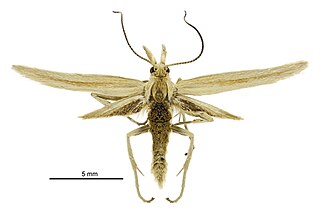
Exsilirarcha is a genus of moths of the family Crambidae. It contains only one species, Exsilirarcha graminea, which is endemic to New Zealand. Both the genus and the species were described by John Salmon and J. D. Bradley in 1956.

Mnesictena is a genus of snout moths in the subfamily Spilomelinae, where it is placed in the tribe Udeini. The genus was erected by the English entomologist Edward Meyrick in 1884. The currently known seven species are exclusively found on New Zealand and the associated Antipodes Islands and Chatham Islands.

Campbellana is a genus of moths of the Carposinidae family, containing only one species, Campbellana attenuata. This species is endemic to the Campbell Islands of New Zealand.
Sorensenata is a genus of moths belonging to the subfamily Tortricinae of the family Tortricidae. It contains only one species, Sorensenata agilitata, Sorenson's agile moth, which is found in New Zealand, where it has been recorded from Campbell Island.
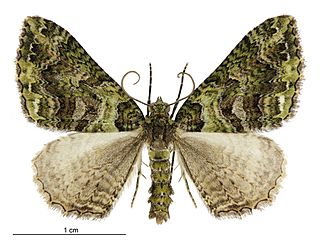
Austrocidaria similata is a species of moth of the family Geometridae. It endemic to New Zealand.
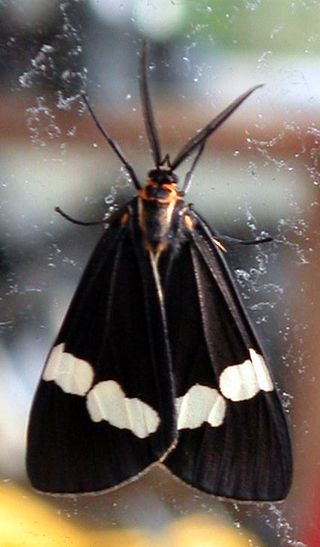
Nyctemera annulata, the magpie moth, is a moth of the family Erebidae. The species was first described by Jean Baptiste Boisduval in 1832. It is endemic to New Zealand and found in all parts of the country.

Dumbletonius unimaculata is a species of moth of the family Hepialidae. It is endemic to New Zealand. This species is host to the vegetable caterpillar fungus Ophiocordyceps robertsii.

Diplopseustis perieresalis is a species of moth in the family Crambidae. It is widespread in the Oriental region, Australia and New Zealand, but was introduced to the Western Palaearctic realm, where it quickly expanded its range, and where it is now found in Great Britain, the Netherlands, Belgium, Germany, France, Switzerland, Spain, Portugal and the Canary Islands. In the Afrotropics, a single female specimen has been collected in 1904 in Sudan.

Planotortrix flammea is a species of moth of the family Tortricidae. It is endemic to New Zealand.

Mnesictena antipodea is a moth in the family Crambidae. It was described by John T. Salmon in 1956. This species is endemic to New Zealand, where it has been recorded from the Antipodes Islands.

Proterodesma turbotti is a species of moth in the family Tineidae. It was described by John Salmon & John David Bradley in 1956. This species is endemic to New Zealand.

Hierodoris bilineata is a species of moth in the family Oecophoridae. It is endemic to New Zealand. This species is classified as "At Risk, Naturally Uncommon" by the Department of Conservation. It is possible that this species gives birth to live young rather than lay eggs as is the norm.

Lysiphragma argentaria is a species of moth in the family Tineidae. It is endemic to New Zealand. It is classified as "At Risk, Naturally Uncommon" by the Department of Conservation.

Ichneutica erebia is a moth of the family Noctuidae. This species is endemic to New Zealand and is found on Campbell Island and the Auckland Islands. Adults of this species are on the wing from August to January. The adults are variable in appearance but can be distinguished from similar species by the patters or lack thereof on their forewings. The larvae of I. erebia are polyphagous and hosts include Pleurophyllum criniferum, species within the genera Stilbocarpa and Carex, as well as Chionochloa antarctica, Urtica australis and Raukaua simplex.
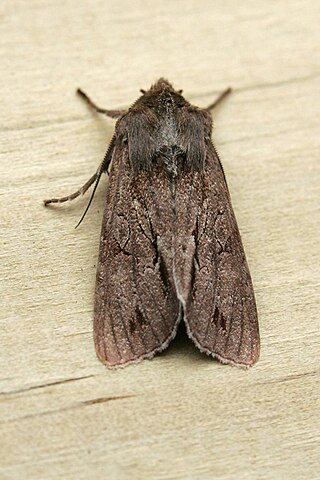
Ichneutica rufistriga is a moth of the family Noctuidae. This species is endemic to New Zealand and is only found in the Antipodes Islands. The larvae of I. rufistriga feed on various host species including Urtica australis and have been reared on Rumex obtusifolius, Stellaria media and Rheum rhabarbarum. It has been hypothesised the larvae might also feed on Austroblechnum durum. The larvae pupate in a cocoon buried in the soil. In captivity it took 12 weeks to raise a generation from egg to adult. Adults of this species have been recorded as being on the wing from October to February.
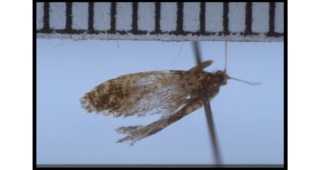
Mallobathra campbellica is a moth of the family Psychidae. This species is endemic to New Zealand and is found only on Campbell Island.

Atomotricha chloronota is a moth in the family Oecophoridae first described by Edward Meyrick in 1914. It is endemic to New Zealand and is found in the eastern side of the South Island and at the Antipodes Islands. It inhabits clearings with native tussocks and ferns. The larvae feed on leaf litter from silk tunnels in soil. The male adults of this species are on the wing from July to September and have been trapped via sugar traps and are attracted to light. The female of this species is brachypterous.



















